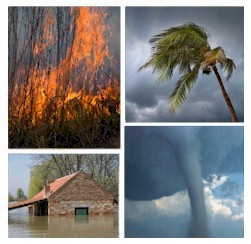|
|


Emergency Notification Systems
 This section of our technical library presents articles written about Emergency Alert Systems and Disaster Recovery definitions, terms and related information.
This section of our technical library presents articles written about Emergency Alert Systems and Disaster Recovery definitions, terms and related information.
The 911Broadcast emergency notification and alert service can deliver a large number of phone calls using a network of phone systems employing digital phone lines simultaneously. Should a disaster such as a snow storm, wild fire or flood hit your area, 911Broadcast systems can alert your community quickly providing specific instructions if an evacuation is required.
This service is available using our emergency broadcasting systems. If a dangerous chemical spill occurs in your community, you can target specific areas to call. If a severe snow storm hits your area, your community can be notified of school closings or event cancellations.
Contact DSC Today for a FREE analysis and quote and to learn more about our emergency notification systems and services.
XML group to help first responders
BY Dibya Sarkar
A consortium of private- and public-sector organizations, university groups and nonprofit agencies are driving an initiative to create standards for using Extensible Markup Language to help first responders and others communicate and exchange information during emergencies.
The group, known as the Emergency Management XML Consortium, expects to submit the first specification to the Organization for the Advancement of Structured Information Standards (OASIS) by year's end. XML eases the exchange of information by tagging data so disparate applications and systems can recognize it.
The lack of interoperable equipment has been a concern for many public safety officials for years, but consortium members said the Sept. 11, 2001, terrorist attacks — when New York City firefighters and police experienced major communications problems with devastating consequences — spurred them to act.
"There was this realization that the problem of interoperability was profound. It was pervasive," said Matt Walton III, vice chairman and founder of E Team Inc., who leads the consortium's executive committee. "It really impacted [a] very broad spectrum of enterprises that were involved in providing products and services in this arena."
The consortium, launched last October, is composed of 52 members so far. The group includes an "open tent" executive committee created to provide policy guidance for standards development as well as outreach and education. It also has a technical committee, formally accepted by OASIS, which will actually design and develop the XML schema-based standards.
Before being accepted by OASIS, the consortium conducted considerable research about what was being done in the XML arena. Rather than reinventing the wheel, Walton said the group wanted to build on what's already been accomplished.
Members of the group learned that there is "not a focused, clearly delineated set of Web standards already under way" for incident management, he said. "There was actually sufficient justification to look at that as a discrete area within a context of all these other areas."
Mark Zimmerman, program manager for the Disaster Management E-Gov Initiative at the Federal Emergency Management Agency, said there's a need to foster communication among parties whether they have a homegrown or commercial product, but any national approach is best done on a voluntary basis and not as a federal mandate to state and local governments.
"What's great about this is that industry really is driving this move toward the standards," he said. "It's not a government-driven initiative. And they're policing themselves, because you're not going to bring 52 of anything together in this town and allow one organization to dominate it."
But he said the federal government does want to ensure that any developed standards be completely open and also fit within the federal enterprise architecture.
Allen Wyke, the technical committee's leader and chief information officer for Blue292 Inc., a developer of crisis information management software, said he likens the development of emergency management XML standards to building kitchen cabinets.
"We're in a time where there are standard sizes for sinks and for dishwashers so we can all build to one, and you know those things will fit in," he said. "There are some variations, but generally speaking, they kind of have their own size. That doesn't currently exist in a way that makes it easy to build software for the emergency management space."
Core areas being researched include unified incident identification, emergency geographic information system data accessibility and usage, notification methods and messaging, situational reporting, source tasking, and asset and resource management. The group will also look at issues surrounding financial tracking and public health as it relates to emergency management. Initially, subcommittees will focus on GIS data, messaging and infrastructure.
Wyke said even incremental improvements can pay dividends to companies using such standards. "The reality is they have data in a lot of different places and what you want to avoid [is] a rip-and-replace kind of scenario," he said. "You want to leverage those data assets in the most efficient way."
Walton said the consortium is accelerating the schedule for developing standards but isn't rushing through them. That was one reason to place the technical effort under OASIS rather than create a new standards-setting body.
"The objective here is not just develop things quickly, but develop things quickly that are validated and then can legitimately be promulgated not just domestically, but internationally," Walton said.
The consortium has set forth an aggressive timetable with the goal of having the first draft of an XML-based standard by the end of June.
Creating standards
The Emergency Management XML Consortium, a group of private and public organizations, is developing standards based on Extensible Markup Language to help public safety workers and first responders using disparate equipment and systems exchange information during emergencies.
Core areas being researched include:
- Unified incident identification.
- Emergency geographic information system data accessibility and usage.
- Notification methods and messaging.
- Situational reporting.
- Source tasking.
- Asset and resource management.
Emergency XML Messaging Solutions
 Automatically send emergency phone messages from your computer system using our XML push software.
Let our phone system automatically access information from your computer systems and web servers using our XML Pull and web information retrieval logic.
Alerts can be automatically broadcast to systems administrators or to an entire department based upon an external event such as a power failure or system failure.
Other applications may be as simple as wakeup calls or weather alerts that are triggered automatically from your own computer systems or websites.
Automatically send emergency phone messages from your computer system using our XML push software.
Let our phone system automatically access information from your computer systems and web servers using our XML Pull and web information retrieval logic.
Alerts can be automatically broadcast to systems administrators or to an entire department based upon an external event such as a power failure or system failure.
Other applications may be as simple as wakeup calls or weather alerts that are triggered automatically from your own computer systems or websites.
Using standard XML protocol, develop applications that transmit messages to our phone systems to perform the required phone messaging tasks. This could including simply sending a single message to one phone number, several phone numbers, or to an entire list of numbers.
The emergency message can be sent in the form of a wav file or a text file that is automatically converted using our text to speech software. Several voice wav files can be designated in the XML push message, giving you maximum flexibility.
Contact DSC for a FREE analysis and to learn more about our automatic phone messaging systems and services.
XML Messaging and How It Works
XML emergency messages can be easily sent from your existing computer applications. Database Systems Corp. supports several "canned" XML message formats, but can develop new formats that fit your requirements.
|




 This section of our technical library presents articles written about Emergency Alert Systems and Disaster Recovery definitions, terms and related information.
This section of our technical library presents articles written about Emergency Alert Systems and Disaster Recovery definitions, terms and related information.
 Automatically send emergency phone messages from your computer system using our XML push software.
Let our phone system automatically access information from your computer systems and web servers using our XML Pull and web information retrieval logic.
Alerts can be automatically broadcast to systems administrators or to an entire department based upon an external event such as a power failure or system failure.
Other applications may be as simple as wakeup calls or weather alerts that are triggered automatically from your own computer systems or websites.
Automatically send emergency phone messages from your computer system using our XML push software.
Let our phone system automatically access information from your computer systems and web servers using our XML Pull and web information retrieval logic.
Alerts can be automatically broadcast to systems administrators or to an entire department based upon an external event such as a power failure or system failure.
Other applications may be as simple as wakeup calls or weather alerts that are triggered automatically from your own computer systems or websites.